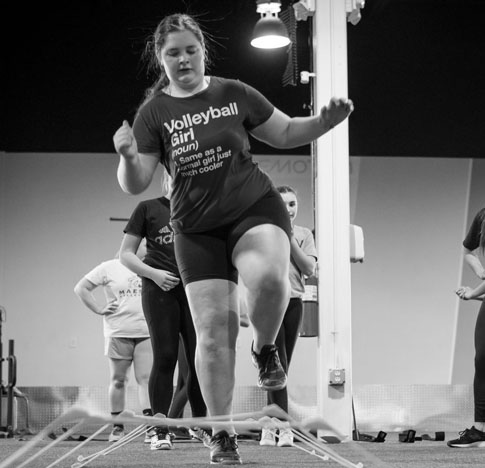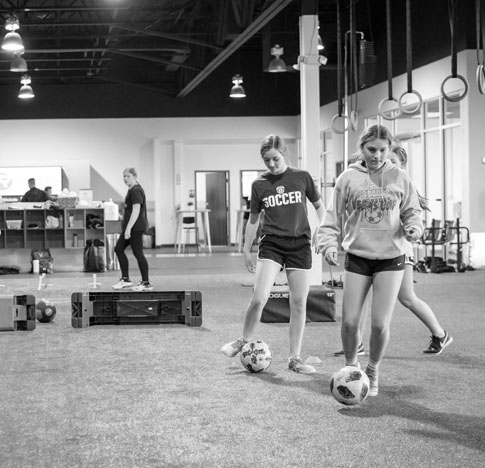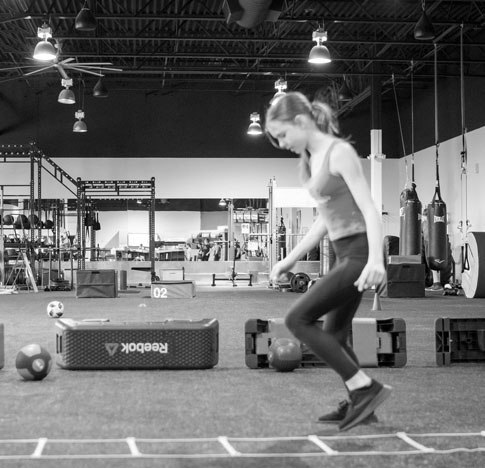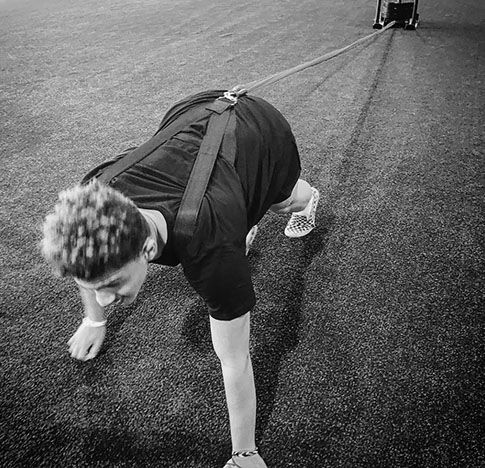Assessment
STRENGTH TESTING
There are 3 separate phases to strength training.
- The 1st is called Hypertrophy the main function of this phase is to increase muscle size, flexibility, and muscular endurance. The theory is bigger muscles can push more weight. We will focus on high reps
- The 2nd is the strength phase in which we will slowly decrease your reps and work strictly on strength and BALANCE. The balance training has been included to help decrease injuries as well as it also stimulates more muscle fibers which will increase the body’s response to the strength workouts.
- The last phase is the power phase. In this phase we work with very low reps but as explosively as possible. This phase incorporates plyometric exercises into the weight program. In this phase the exercises should be done in circuit or superset fashion. This change has also been made to prevent injury. You will also see if you work hard through this phase that your power and explosion will improve dramatically. Power is work/time. That means to truly be powerful the weight or in our case the opponent must be moved as quickly as possible. This workout has three major goals for the off-season and preseason. Those three goals are SPEED, STRENGTH, & POWER.
CONDITIONING TESTING
½ Gasser Test – Test of functional capability of the ATP/CP energy system needed for football and helps determine an athlete’s ability to tolerate lactic acid build-up and fatigue.
Procedure: Run 8 ½ Gassers (width of the field twice) as hard as possible
Goal Times: must average the following times
DB/QB/TB/WR = 15 sec.
FB/LB/TE/K = 16 sec.
OL/DL = 17 sec.
Rest Interval: 45 sec.
Gasser Test – Test of functional capability of the ATP/CP energy system needed for football and helps determine an athlete’s ability to tolerate lactic acid build-up and fatigue.
Procedure: Run 4 full Gassers (width of the field 4 times) as hard as possible
Goal Times: must average the following times
DB/QB/TB/WR = 35 sec.
FB/LB/TE/K = 37 sec.
OL/DL = 40 sec.
Rest Interval: 1min. and 15 sec.
10 40’s Test – This is a test of speed endurance Procedure: Sprint 10 40-yard dashes
Goal Times: must run all 40’s under the goal time
Goal Time: best 40 yard dash + .50 sec
Rest Interval: 30 sec
110’s Test – Test of speed endurance and overall endurance
Procedure: Run 16 110 yard sprints
Goal Time: must make the specified time for your position group as follows
DB/QB/TB/WR = 15 sec.
FB/LB/TE/K = 17 sec.
OL/DL = 19 sec.
Rest Interval: 45 sec.
Small Tempo Run – Test of overall endurance and recovery. Procedure: Run the following sets of Sprints
(100,100,100,200) (100,200,100,200) (200,100,200,100)
Rest Interval: 30 seconds between Sprints, 1 min between sets
300 Yard Shuttle – This is a test of endurance and how quickly you can recover from a maximum effort
Procedure: Run the shuttle 25 yards 12 time (or 25 yards down and back 6 times)
Goal Time: must make the specified time for your position group as follows
DB/QB/TB/WR = 1 min.
FB/LB/TE/K = 1 min. 5 sec.
OL/DL = 1 min. 10 sec.
600 Yard Shuttle – This is a test of endurance and how quickly you can recover from a maximum effort Procedure: The run is done over a 60-yard area. Run the 60 yards back and forth five times consecutively for a total of 300 yards. You will then rest one minute and perform the run again in the same manner for another 300 yards. Time each run and add your two time together for the result. Goal Time: Must make the specified times for your position group as follows.
DB/QB/TB/WR = 98 sec.
FB/LB/TE/K = 105 sec.
OL/DL = 125 sec.
Long C.O.D. – (Change of Directions). This is a conditioning drill as well as a quick change of direction exercise.
Procedure: Like suicides in basketball. 10 yards and back, 20 & back, 30 & back, 40 & back, 50 & back, consecutively
11 Minute Sprint Drill – This is a conditioning sprint drill. Test of functional capability of the ATP/CP energy system needed for football and helps determine an athlete’s ability to tolerate lactic acid build-up and fatigue.
Procedure: Run the following sprints complete all the sprints in no more than 11 minutes. 2 x 100 yards
4 x 80 yards
5 x 60 yards
6 x 50 yards
8 x 40 yards
10 x 20 yards
Physical Literacy
Vertical Jump test
Broad Jump test
10yard acceleration
10yard change of direction
Squat Test – 1minutes
Plank Hold Test
Push Up / Bench Press Test
½ Mile and 1 Mile test
Balance Test
Bosu Ball cone touch
Bosu Ball Squat
Grape Vine lateral Walk
Heel Toe walk
One leg Hops
Medial Single hops
Cognitive testing
Self-Perception test
Self-Expression test
Decision making test
Stress management test
Interpersonal test
Health History
Injuries and Performance history
Special Drills
- Lying Starts – Start by lying on your stomach. On command from the lying position sprint for 20 yards.
- Flying 20’s or 40’s – Start with a 15-yard jog. When you reach the 15-yard mark sprint for 20 or 40 yards.
- Ball Drop Drill – This drill is to work on your starts and quickness. Start by having your partner stand 5-7 yards away. Your partner is holding a tennis ball straight out from their shoulder. Upon your partner dropping the ball, you sprint straight forward and catch the ball before it bounces twice.
- Stick Drill – Here the athlete does fast-stepping over 20 sticks that are laid out 18 inches apart on the track. The athlete can use a high knee action or ½ high knee action to get over the sticks and this drill can be timed to determine if the athlete is getting in more strides per unit time (increased frequency). Emphasis must be placed on using correct arm action while doing this overspeed drill which is done for 3-5 reps as a leadup drill on the speed day workout. To improve the benefit of this drill the athlete can make the transition into the run (at 20 yards) at the end of the sticks while maintaining a fast stride frequency.
- High Knees – Here the athlete does a high knee drill for a timed period of 5 seconds while moving slightly forward (one yard every three strides). He counts one of his legs and is then able to determine how many strides he took during the 5 seconds by multiplying by 2(10 x right leg x 2 = 20 strides/5 sec. = 4 strides per sec.) Emphasis should be on high knee action (thigh parallel) and good arm action. This drill is done for 3-5 reps as a lead up drill on the speed day and, as with the stick drill, can be more beneficial if the athlete makes the transition into a casual run (at 20 yards) at the end of the timed high knee period.
- Assistive Running – by running with the assistance of surgical tubing (or downhill), the athlete can experience the sensation of running faster than normal. We will do assistive running from an upright position with the partner (anchor) standing in a stationary position or moving backwards to extend the pull. The key here is that athletes use proper running form and increase their stride frequency to stay up with the pull of the tubing. Players can run .3-.4 seconds faster in the 40-yard dash with the assistance of this tubing. For athletes who do not have access to surgical tubing, they can do downhill runs on a shallow grade (3-5 degrees) as an alternate exercise. We will do this exercise on our speed day for the last 4 weeks of the off-season program to develop stride frequency.
- Resistive Running – here the athlete will run out of a sprint stance or upright against a resistance provided by his partner, the harness, and the surgical tubing for 20-30 yards. This exercise forces the athlete to get better drive on the push off each running stride and helps to develop stride length. (An alternative to harness running is to do this work on a slight uphill grade (8-10 degrees) which will provide the same benefit.) We will do this exercise on or speed day for the last 7-9 weeks of the off-season program.
- Buildups – start from a standing position, start into a slow run, concentrating on good running form. Gradually build up speed until you are at full speed at 40 yards. Once full speed is achieved at 40 yards, gradually slow down over the final 20 yards.
- Hollow Sprints – Set up a 100-yard course with every 20 yards point marked. Start running at half speed for the first 20 yards. At the 20-yard point accelerate and sprint for 20 yards. Repeat this half speed and sprint pattern until the course is complete. Complete 3-5 reps with 60-90 seconds rest between.




